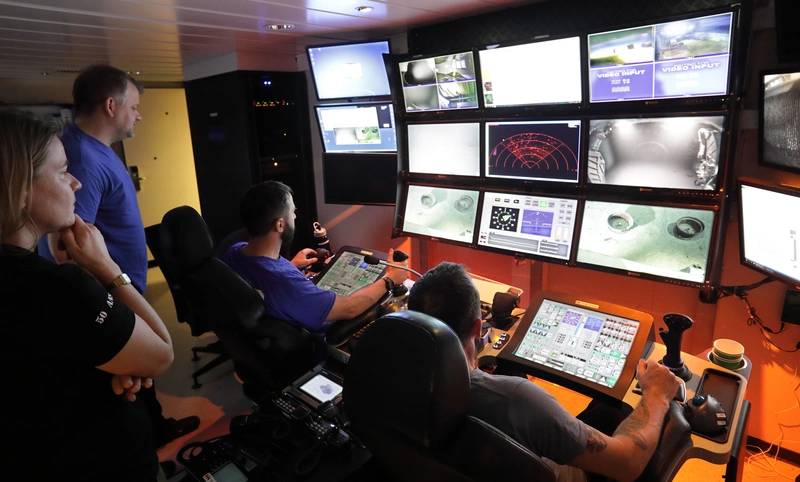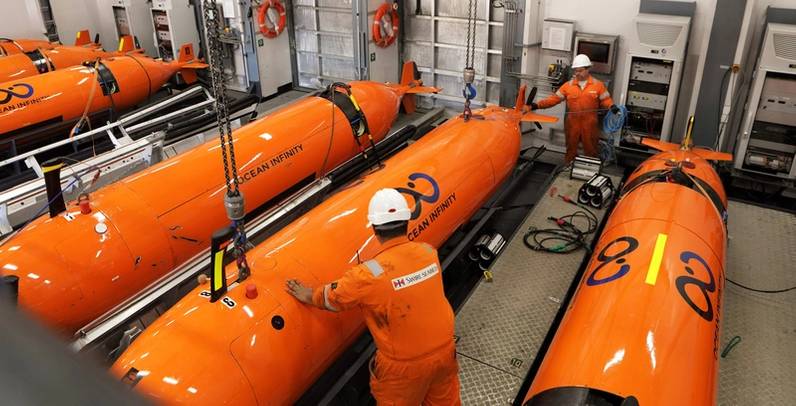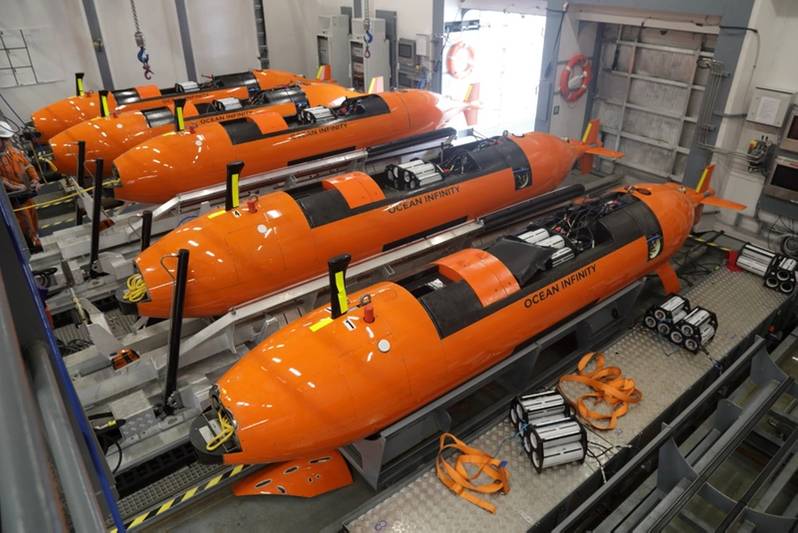Ocean Infinity’s Hunt for the Submarine San Juan
The search for the Argentinian submarine was like hunting for the proverbial needle in a hay stack, except that it was a piece of straw. Elaine Maslin reports.
At 7.19am, local time, on November 15, 2017, the last message was received from the San Juan submarine. She belonged to the Argentinian navy and was on a routine mission from Ushuaia in the Patagonia region to Mar del Plata in Buenos Aires province when she lost contact with the military.
Fifteen days later, neither the submarine nor any debris had been found and the crew of 44 sailors were presumed dead. The loss made international headlines, as did the ongoing search, as the families of those presumed dead wanted to know what had happened. It was thought the submarine had encountered a problem with the forward batteries, but little information was available.
An initial search proved futile. There was little to go on, except an unusual signal detected by two of 11 Comprehensive Nuclear-Test-Ban Treaty (CTBTO) hydroacoustic stations that are dotted about the world. They were hydroacoustic stations HA10 (Ascension Island) and HA04 (Crozet), which detected a signal from an underwater “impulsive event” at 13:51 GMT on 15 November. Despite this clue, it would turn into one of the most challenging searches.
To read the story in the eMagazine version of Marine Technology Reporter, visit: https://magazines.marinelink.com/nwm/MarineTechnology/202003/#page/37 The search for the San Juan was one of Ocean Infinity’s most challenging. Source: Ocean InfinityReducing the ellipse
The search for the San Juan was one of Ocean Infinity’s most challenging. Source: Ocean InfinityReducing the ellipse
“The challenge for the searchers was that the acoustic anomaly had a large ellipse,” Rear Admiral Nick Lambert, Ocean Infinity’s project manager on the project told the Marine Autonomy and Technology Showcase event in Southampton late last year. To narrow it down, a defined charge was dropped at a known time, which would help to refine the understanding of the acoustic signal and reduce the ellipse. It showed the submarine had dropped in water deeper than 100m, which meant it was beyond the recoverable water depth.
The search, however, continued and Ocean Infinity was brought in. Since the firm started operating in 2016, disrupting the autonomous underwater vehicle (AUV) space by deploying multiple AUVs from one vessel on search or survey missions, the company has made a name for itself in a number of international search efforts.
Ocean Infinity committed to conduct the search operation for up to 60 days and to covers its cost, unless the submarine was found. It deployed its Seabed Constructor vessel with five Hugins. The initial 10-12 days covered three, what were thought key, search areas. But the submarine wasn’t found. “We went back and brought in more experts to think about what happened and expanded and expanded the search.”
Ocean Infinity’s setup is geared to find things on the seabed, quickly. Its Hugins are capable of operating in water depths from 5- 6,000 m and cover vast areas of the seabed quickly. They are equipped with a variety of tools including side scan sonar, a multi-beam echo-sounder HD camera, and synthetic aperture sonar.
However, the search for the San Juan had to deal with challenging underwater terrain, “full of an astonishing number of submarine sized and shaped rocks, trenches and a steep drop-off the continental shelf, which complicated the search,” says Oliver Plunkett, Ocean Infinity’s CEO. The ship had a host of experts to help in the hunt, including members of the Argentinian Navy, the UK’s Royal Navy, via the UK Ambassador in Buenos Aires, and the US Navy's Supervisor of Salvage and Diving. Three officers of the Argentine Navy and four family members of the crew of the San Juan also joined Seabed Constructor to observe the search operation. The pressure was on.
After the initial search, the AUVs were re-programmed to fly riverbed formations on the seafloor to detect anomalies. "When look at them [anomalies detected in the sonar data] they all look like spooky sub shapes,” said Lambert. Submariners who had been consulted had thought it would end up in a canyon. It was also predicted that submarines tend to break into three, and the implosion creates a small debris field.
Finally, data from the five Hugins led the team to position to a spot where there was a shape described as nearly 200 feet long – roughly the size of San Juan. It had already identified and inspected 23 possible detections – each one of which had led to false hope for the crew, Argentinian navy members and not least the San Juan crew family members onboard. This one was in the area which had had the highest possibility of finding it. But it wasn’t in an expected position, the shape was perched on top of a geological feature and “it was hard to determine if it was geology or manmade.”
 Ocean Infinity’s Hugin’s now have longer batteries. Source: Ocean Infinity
Ocean Infinity’s Hugin’s now have longer batteries. Source: Ocean Infinity
At 11 pm, local time, on November 2018, a remotely operated underwater vehicle (ROV) was launched from the Seabed Constructor to take a closer look at get better images. Near to midnight, the images captured by the ROV confirmed that it was indeed the missing San Juan. It was found in 920 m water depth, about 600 km east of Comodoro Rivadavia in the Atlantic Ocean; a year and two days after her loss.
The search had seen Ocean Infinity cover an area the size of south east England to find an object the size of two buses, says Plunkett. Even with the benefit of knowing where it was and its condition, “it was one of the most challenging targets we have ever attempted,” he said. “It was found sitting on the downslope of a geological ridge at a 10-degree angle with parts of the submarine falling further down the slope. The large hull section was nearly perfectly aligned with the ridge line, which in itself was at the end of an area of clear rockfall. The hull was twisted and deformed into a non-linear feature. The thruster propeller had wholly fallen away from the shaft and the torpedo tubes were exposed. The chances of it being in that location aligned in that way are nearly nil. It is also important to remember it was an object approximately 60 meters long designed not to be detected by sonar. It was the proverbial needle in a haystack – except it looked like a piece of straw.”
As part of its search, Ocean Infinity looked at what happened to other submarines, such as the Thresher and USS Scorpion, but kept an open mind, planning around finding the smallest likely intact piece. This could have been, for example, the submarine’s sail. “When a submarine goes beyond the crush depth (in the ARA San Juan’s case around 596m) it first implodes and then explodes. Hence the destruction field of the imploded submarine remains small,” he adds. This explains why wreckage on the surface was never found.
It’s not just a technical project. Plunket says that the importance of the families of those that were lost with the vessel was central to the mission, which was why a team of family representatives as well as Armada Argentina crew were onboard the Seabed Constructor during the search. “The additional pressure to succeed for the families who were onboard with our team 24/7 and the pain of failure as each of those first 23 targets was revealed to be a miss was a massive challenge that I was extremely proud that our team rose to,” he says.
Last year, an Argentine legislative commission released its findings on the cause of the sinking of the San Juan. It said that, on the night before the ARA San Juan disappeared, water had entered its ventilation system and caused a fire in one of its battery tanks. The vessel surfaced and continued sailing. The captain reported that he was ready to descend to 40 m to assess the damage and reconnect the batteries the next day, but nothing more was heard from the submarine. Budget limitations and naval inefficiencies were cited as contributing factors.
Ocean Infinity, meanwhile, continues to grow. It now has three multipurpose support vessels, the latest being the Normand Frontier. Each is equipped with five AUVs, three unmanned surface vessels (USVs), two ROVs and a full ocean depth hull mounted multi-beam echo-sounder, deep water 45-tonne fiber rope winch and construction class crane. The Normand Frontier was mobilized in November 2019 on a three-year charter from Solstad Offshore. It was recently the host vessel for a seabed data project in Angola for Total. The Hugins now also have new 6000 m depth tolerant batteries from Kraken Robotics subsidiary, Kraken Power, that extend battery life from 60 to 100 hours. This allows for missions to be conducted across a period of more than four days without a battery change. Ocean Infinity says that the technology, when partnered with its multi-AUV approach, increases the possible survey range to nearly 700 line km per AUV.
It’s not all smooth sailing. Last year one of its Hugins was lost in the Weddell Sea in pack ice. Another was also lost during the MH70 search. “It’s not a failure,” says Lambert. “It’s not being afraid to go and push boundaries.” Ocean Infinity has been doing just that. In fact, just last month [February] it launched a new company, Armada, with plans to build a fleet of 15, 21-37m long unmanned surface vessels, or robotic ships, as they were named. Construction has started and some will be operational this year, Dan Hook, the firm’s managing director (formerly in the same role as ASV Global, now owned by L3Harris) told the launch event.
 Ocean Infinity’s Hugin’s now have longer batteries. Source: Ocean Infinity
Ocean Infinity’s Hugin’s now have longer batteries. Source: Ocean Infinity
Other stories from February 2020 issue
Content
- Remotely Operated Vehicles: Thinking out of the Box page: 12
- Electric Motor Selection for Underwater Vehicles: Considerations of Partial Load Efficiency page: 18
- Environmental DNA Emerging in the Ocean Science Community page: 20
- Ocean Infinity’s Hunt for the Submarine San Juan page: 34
- MBARI Works at Unlocking Ocean Biology page: 42
- Copenhagen Subsea Debuts the Gorilla ROV page: 50

